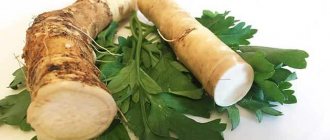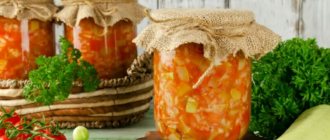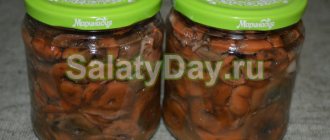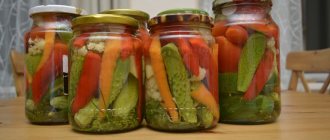Origin story
The true meaning of the name comes from the Abkhaz word meaning bread and salt. A phrase similar to the Russian hospitable greeting of dear guests. The spice was invented by Abkhazian shepherds, concerned about how to save expensive salt. Sheep owners gave it out in portions so that the animals, along with the seasoning, would drink more water, eat juicy grass and gain weight well. Knowing the shepherds’ predilection for salted food, the flock owners sprinkled the mixture with hot pepper. The shepherds figured out how to outwit this situation and began to grind the ingredients with herbs.
The classical method does not recognize any tools for rubbing, except stones. With their help, they made a paste from walnut kernels, garlic, pepper, and herbs.
Interesting Facts
Russian people first tried and learned how to prepare adjika in the 19th century, when Georgia became part of the Russian Empire. Since then, experiments have continued with recipes and cooking that suit the usual taste of Russians.
Technology for preparing classic Abkhaz seasoning
According to ancient tradition, real adjika is prepared on a flat stone, which has a slight wear in the center. The counter part, which is used to grind the ingredients, is also stone, but smaller in size. The rubbing stone is pressed from above with the left hand, and circular movements are made with the right. With the help of such a device, the Abkhazians also ground walnuts, roots or chestnuts.
Using stone grinding allows you to make adjika a very thin consistency, similar to butter. Therefore, sometimes I want to call this product “Caucasian oil”. Abkhazians use adjika with almost any food and cannot imagine life without this magical seasoning.
Unfortunately, nowadays there are many fakes that have nothing in common with the classic Abkhaz adjika. Beautiful labels can deceive even a true gourmet. Particularly strange are the inscriptions that say that adjika was made somewhere in the Moscow region, or that the composition of adjika contains tomato paste. But the most offensive thing is the fact that the origin of this magnificent product is attributed to Georgian cuisine, mistakenly assuming that it was they who created the ideal recipe for seasoning with the Abkhaz name.
Composition of adjika
Since ancient times, recipes have been preserved on how to prepare adjika from red or green pepper. The color of the dishes will be appropriate, and the taste will still be sharp. As for tomatoes, tomatoes were not originally included in the composition. They were not grown in the mountains. However, residents of the valleys began to add additional vegetables to soften the taste.
Preparation of adjika as the main ingredients involves garlic and salt in the proportion: 400 g per 2 tablespoons.
Advice. Read the label of a store-bought product carefully. The composition of real adjika is distinguished by a simple set of ingredients without additional preservatives.
Where can I add it?
Dry adjika can be added not only to meat dishes, but also to vegetable products. The seasoning goes well with lamb and pork skewers, grilled chicken wings and thighs, stewed and boiled meat.
In addition, the product can be placed on the table along with fried zucchini, blueberries, fish, and boiled jacket potatoes.
This sauce can also be used to season vegetable stews, various salads, and dishes that include beans or rice.
In addition, adjika is added to tkemali sauce to improve the taste and aroma of the latter.
Adjika raw
The recipe for delicious adjika consists of the following products:
- 500 g – hot pepper;
- 500 g – sweet pepper;
- 200 g – parsley;
- small bunches of celery, basil, cilantro, dill.
If desired, add saffron, marjoram, fenugreek, and peppermint to the list of seasonings.
Interesting Facts. Megrelian adjika, originally from western Georgia, is considered the most spicy. Reminiscent in appearance and composition of Italian pesto sauce.
Adjika dry
Fresh and dry herbs are used for dressing. The bright taste is given by enzymes of spicy dried herbs: coriander, calendula, suneli hops. The dry mixture includes crushed chili pepper and dried garlic. The entire collection is added to tomato paste or
into red wine. It turns out adjika in the form of a sauce for khinkali, chakhokhbili, shish kebab or Russian stewed potatoes with meat.
Cooking features
In mountainous conditions, people prepared the classic product in clay dishes. Now this utensil is a thing of history. It is necessary to use the container correctly, especially if the food is cooked. Metal cups oxidize, but enamel cups will come in handy.
Gloves to protect your hands from interacting with hot peppers are necessary, otherwise burns cannot be avoided.
Real adjika must be done slowly, thoroughly, with soul, following consistency.
- Garlic, pepper, herbs are washed and dried.
- Remove the seeds and stem from the peppers.
- Grind the components with herbs in a meat grinder.
- Add spices and salt.
- Place in sterilized glass jars.
The raw seasoning is ready for use after three days.
Advice. For people with high acidity, kidney disease and gastrointestinal tract, a recipe for adjika without pepper is suitable.
Fresh adjika is usually very spicy and causes a burning sensation in the mouth. You should not drink water, it will make things worse. Kefir and milk will quickly help reduce the spiciness.
Adjika recipes
It is customary for different nations to prepare homemade adjika for the winter according to their own recipe. New products are added, some spices are rejected, but the constituent elements remain unchanged - hot pepper, garlic, herbs.
The seasoning has been popular among Russian housewives since Soviet times. During the years of so-called stagnation, when delicacies were not available, manipulation of vegetables helped diversify the menu.
"Soviet" adjika
Grind vegetables in a meat grinder:
- 5 kg tomatoes;
- 1 kg hot pepper;
- 10 apples;
- 10 carrots.
Cook the finished mixture for 2.5 hours.
During this period, prepare the following batch of products:
- 3 cups sugar;
- 0.5 l vegetable oil;
- 0.5 liters of vinegar, diluted, as for dumplings;
- 300 g hot pepper, ground in a meat grinder.
Add to the cooked mixture, stir and cook for another 30 minutes.
Lastly, add 300 g of ground garlic and boil for 10-15 minutes.
Salt to taste. Pour the hot mixture into the treated container and roll up the lids.
Advice. It is recommended not to throw away pepper seeds, but to dry them and use them for preparing other dishes.
Adjika is a seasoning that contains many components, including spices and herbs. This seasoning appeared in the Caucasus and became very popular there, and then it was happily used in the cuisines of many countries. Adjika gives dishes a special taste and aroma: spicy, subtle and bittersweet. The color of adjika depends on its composition: it can be brown, orange, red or green. In Georgian cuisine, as in the cuisines of other peoples of the Caucasus, this seasoning is considered the main one, and can be presented in the form of powder or paste, which are added to various dishes. Adjika is also called freshly prepared sauce. Adjika appeared in Abkhazia, and the word itself means nothing more than “salt”. Abkhazians call adjika “ pepper salt ”, or “salt ground with something” - depending on the composition of the seasoning.
According to legend, adjika was invented by Abkhazian shepherds when they were herding sheep in the mountains. The owners of the sheep gave them salt with them to add it to the animals' food: the sheep, having eaten salt, were thirsty, but they were not given water; then the animals were forced to eat grass in large quantities to quench their thirst, and very quickly gained weight, which was beneficial to the owners.
Apparently, salt at that time was quite expensive, so it was saved, and shepherds were forbidden to salt their food with it. To prevent shepherds from violating the ban, sheep owners added red pepper and spices to it: cilantro, garlic, suneli hops and others, hoping that the shepherds would not like it. However, the shepherds, on the contrary, really liked the mixture, and they began to add other components to it, subsequently calling it adjika. Now there are many varieties of adjika , but in any case, its composition includes salt, hot red pepper and garlic, to which are added fresh green herbs, or dry, ground into powder. Dry adjika includes coarse salt, hot ground red pepper, coriander seeds, dried garlic, grated walnuts, dill and suneli hops. The last component is also a mixture - a greenish powder of dry spices, distinguished by a subtle and fragrant, but rather strong aroma and moderately spicy taste; this mixture is widely used in Georgian cuisine and the cuisines of other peoples of the Caucasus. Typically, suneli hops contain coriander, celery, fenugreek, dill, parsley, savory, basil, marjoram, bay leaf, peppermint, saffron and red pepper.
with orange and red adjika - for this, it is ground with walnuts, and then a special oil is squeezed out of the resulting dough and used in the preparation of various dishes. These can be meat, vegetable and egg dishes, with herbs, herbs and the same walnuts.
Classic Abkhazian adjika is prepared by grinding it on a special stone: large, flat, rectangular or round in shape. The stone is called a grater, and the components are ground with another stone, similar, but smaller. With the help of such stones in Abkhazia, spices and seasonings were always ground and prepared, which could include both cultivated plants and wild herbs. When the components are ground on a stone, adjika has a consistency similar to soft butter, so it can be spread on bread, pita bread, and flatbreads.
The composition of adjika, although its name translates as “salt,” does not contain much salt itself. Adjika is eaten with cheese, boiled meat, vegetables and even melons; added to vegetable and meat dishes, sauces, and even dairy products. Almost no food in Abkhazia is prepared or eaten without adjika, used in various forms. However, there have never been and cannot be tomatoes in real adjika: it was the Russians who came up with a version of the seasoning in which tomatoes partially and sometimes almost completely replace pepper - so the seasoning becomes less spicy, but retains its rich red color. To obtain a paste, add low-alcohol wine vinegar to dry adjika or simply dilute the powder with warm water, adding sugar and salt to taste. The result is a thick, wet paste; If no new components are added to it, then adjika is called red. Green adjika is obtained by adding a large amount of chopped herbs to the pasta - most often these are basil and cilantro, which make up half of the total volume of the seasoning. In this case, red pepper can be replaced with green, also hot, but such adjika, unlike red or dry, does not last long - only a few weeks. Fresh seasoning is prepared from the same ingredients as dry seasoning, but they are used fresh, and the pepper is not red, but hot green. Adjika is added not only to meat and fish dishes, but also to rice, as well as beans, from which lobio is prepared - a famous dish of Georgian cuisine.
Typically, 1 tbsp is added to 1 kg of meat, fish or 1 liter of water. adzhiki. Dry adjika is added to broths, soups, sauces, and marinades; red - in borscht, dishes of fried meat, eggs, walnuts, herbs and even in plum sauce, known as tkemali.
Green adjika is less spicy, and is used to prepare many of the dishes listed above, and is also added to squash and eggplant caviar, vegetable stews, cottage cheese and fresh cheese, and sauces. Green adjika is not added to fried dishes. Adjika is used not only in cooking, but also for medicinal purposes . This is an excellent remedy for improving appetite: if you eat a small piece of bread with adjika before lunch, any dish will seem tastier. Surprisingly, such a spicy seasoning as adjika can prevent the occurrence of stomach ulcers and other gastrointestinal diseases, as it improves metabolism, normalizes digestion and the functioning of the circulatory system. However, in acute and chronic gastritis, exacerbations of liver and kidney diseases, adjika is contraindicated; It should also not be used by pregnant women and young children. For frequent colds, adjika also helps, as it strengthens the body’s defenses and kills viruses, but all these properties are distinguished only by the original classic adjika , which contains salt, hot pepper and garlic, as well as other spices used in the Caucasus. Caucasian men also claim that adjika helps to increase male strength and sexual activity, as it makes them energetic and alert, stimulates blood circulation and the function of the gonads. This is quite believable, since they often have a reputation as tireless lovers. Residents of Georgia consider adjika to be their invention, and residents of Abkhazia do not want to cede its “authorship” to them. However, both Georgian and Abkhaz seasoning are prepared from similar ingredients, although they differ in composition.
Georgian adjika usually includes dry red pepper, suneli hops, cinnamon and coriander, garlic, walnuts and salt - always coarse. The Abkhazian seasoning does not include suneli hops and cinnamon, but dill and purple basil are added to the main ingredients. Today you can prepare any adjika: there are many recipes, and all the ingredients are easy to buy, and you don’t need to use stones to grind them, since there is a wide variety of kitchen appliances. However, real adjika is prepared by hand, and not only tastes, but also smells are mixed in a special way, so in order to try it, it’s worth visiting the Caucasus.
Here are some recipes for making ADJIKA.
5 kg of tomatoes, 1 kg of sweet pepper, 16 pieces of hot pepper, 300 g of garlic, 0.5 kg of horseradish, 1 cup. salt, 2 cups. vinegar, 2 cups. Sahara. Grind everything in a meat grinder, including the seeds from the pepper (only the tails are cut off and the inside is not cleaned), add sugar, salt, vinegar, let stand for 50 minutes, pour into bottles. No need to boil. Stores well in bottles without refrigeration.
200 g garlic, 4 sticks of horseradish, 2 bunches of parsley, 2 bunches of dill, 10 sweet peppers, 20 hot peppers, 2 kg of tomatoes, 4 tbsp. l. sugar, 4 tbsp. l. salt, 1 cup. vinegar. Pass through a meat grinder with a fine grid, add salt and sugar. Let it sit in the bowl for 2-3 days, then add vinegar, mix well and put into jars.
5 kg of tomatoes, 2 kg of apples, 2 kg of carrots, 2 kg of sweet pepper, 300 g of hot pepper, 300 g of garlic, 1 liter of vegetable oil. oil, 2-3 tbsp. l. salt. Pass everything through a meat grinder, add salt, butter and cook for 2 hours. Seal in sterilized jars.
5 kg of tomatoes, 1 kg of carrots, 1 kg of bell pepper, 5-10 pieces of hot pepper, 0.5 kg of onion, 0.5 l of vegetable oil. oils, 5-7 heads of garlic, salt. Pass everything through a meat grinder and cook for 2 hours.
5 kg of tomatoes, 1 kg of sweet pepper, 0.5 kg of horseradish, 300 g of garlic, 16 pieces of hot pepper, 2 cups. vinegar, 2 cups. sugar, 1 cup. salt. Do not clean the inside of the pepper, remove only the green tails and leave the seeds. Pass everything through a meat grinder, add vinegar, sugar and salt. Let stand for 50 minutes, then pour into a clean container. No need to cook, store without refrigeration.
2.5 kg of tomatoes, 1 kg of apples (Antonovka), 1 kg of carrots, 1 kg of sweet pepper, 1 cup. sugar, 1 cup. rast. oil, 3 pods of hot pepper, 200 g chopped garlic, salt. Grind tomatoes, apples, carrots and sweet peppers through a fine grinder and boil for 1 hour. After boiling, add sugar, sunflower oil, hot pepper, garlic and salt. Do not boil, just bring to a boil. You can add more or less hot pepper (to taste).
5 kg of ripe tomatoes, 5-6 heads of garlic, 100 g of salt, 1 hot pepper, 6 large horseradish roots, sweet pepper. Pass everything through a meat grinder, stir and place in containers, store in the refrigerator.
1 liter of tomatoes ground in a meat grinder, 1 cup. garlic cloves, 1-2 tbsp. l. salt. Let the crushed and salted tomatoes and garlic sit for a couple of hours until the salt dissolves, remembering to stir at least a couple of times, and pour into sterilized jars.
1 kg of sweet pepper, 250 g of hot pepper, 250 g of garlic, 250 g of dill, 250 g of parsley, 250 g of salt. Pass all ingredients through a meat grinder. Mix with salt, adjika is ready.
1 kg carrots, 1 kg sweet peppers, 1 kg apples (Antonovka), 4 kg tomatoes, 0.5 cup. salt, 2 cups. peeled garlic, 1.5 cups. rast. oil, 2-3 pods of hot pepper. Grate everything or put it through a meat grinder. Cook for 30-40 minutes. and close them in jars. You can add more or less garlic and hot pepper, depending on your taste.
1 kg of dry hot red pepper, 50-70 g of coriander seeds, 100 g of suneli hops, a little ground cinnamon, 200 g of walnuts, 300-400 g of coarse salt, 300 g of garlic. Soak the hot red pepper for an hour. Add coriander, suneli hops, cinnamon, nuts, garlic and salt. Pass 3-4 times through a meat grinder with a fine grid. Store anywhere, at any temperature, but preferably in a sealed container, otherwise it will dry out. Adjika mixed with salt is good for coating chicken or meat before frying in the oven.
1.5 kg of tomatoes, 1 kg of eggplants, 300 g of garlic, 1 kg of sweet pepper, 3 pods of hot pepper, 1 cup. rast. oils, salt, 100 g vinegar.
Pass all the ingredients through a meat grinder, add oil and, placing in an enamel pan, boil for 40-50 minutes. Add vinegar at the end of cooking. Roll into prepared jars.
2 kg of tomatoes, 20 sweet peppers, 10-15 bitter peppers, 400 g of garlic, 3 horseradish sticks, 2 bunches of parsley, 2 bunches of dill. Grind everything in a meat grinder, then add 4 tbsp to the resulting mixture. l. salt, 4 tbsp. l. sugar and half a bottle of vinegar. Mix, pack into jars, and cover with plastic lids.
5 kg of ripe tomatoes, 1 kg of garlic, 500 g of hot pepper, salt. Pass everything through a meat grinder, add salt, and leave in an enamel bowl for 10-15 days so that the adjika ferments, remembering to stir it daily. You should salt the tomato juice before adding the garlic and pepper, otherwise you won’t feel the taste of salt later.
1.5 kg of tomatoes, 0.5 kg of carrots, red sweet bell peppers and apples, 300 g of garlic, 3-4 pods of hot pepper, 0.5 l of vegetable oil. oils
Peel the tomatoes and apples, chop the peppers, divide the garlic into slices, chop finely, mince everything (except the garlic), pour over the plant. oil and simmer over medium heat for about 2 hours. 10-15 minutes before readiness, add garlic, let it boil, pour hot into sterilized jars and seal.
2.5 kg of tomatoes, 1 kg of carrots, 1 kg of sweet (red) pepper. Pass everything through a meat grinder. Add 1 stack. rast. butter, 1 cup. sugar., 1/4 cup. salt. Place the mixture in an enamel pan and simmer, stirring, for 1 hour. Remove from heat, cool. Then add 1 cup of garlic, minced, 2 pods of hot pepper. Pack cold adjika in sterilized jars and seal, or with plastic lids.
5 kg of ripe tomatoes, 1 kg of bell pepper, 1 kg of apples (the more sour the better), 1 kg of carrots, 2 tbsp. l. salt, 200 g sugar, 400 g plant. butter, 2 tbsp. l. red hot pepper (you can put 1 tbsp black, 1 tbsp red).
Pass all the vegetables through a meat grinder (it is better to peel the tomatoes first). To make tomatoes easy to peel, they need to be poured with boiling water for 5-7 minutes. Season with butter, sugar, salt, spices and simmer for 2-5 hours until the desired consistency. Pour the finished adjika hot into sterilized jars, roll up and wrap.
3 kg of ripe tomatoes, 8 bell peppers, 5 heads of garlic, 1 glass of sunflower oil, 1 glass of sugar, 3 tablespoons of salt, 4 pods of hot pepper.
Pour oil into a bowl and bring to a boil, add the tomatoes minced through a meat grinder and cook for 1 hour. Then add bell peppers and garlic, twisted in a meat grinder, and cook for another 15 minutes. If you like spicier adjika, add hot pepper along with bell pepper; if you don’t like it spicy, add hot pepper with tomatoes. Seal in sterilized jars.
Adjika from plums.
2 kg plums, 300 g garlic, 200 g sugar, 3 - 4 pods of hot red pepper, 2 tbsp tomato paste, 2 tbsp salt.
Rinse the plum well and remove seeds. Cut off the tails of well-washed hot peppers. Peel the garlic. Drain the garlic and pepper through a meat grinder, add sugar, tomato paste and salt. Mix everything well and cook for 20 minutes, stirring constantly.
Place the finished adjika into sterilized jars and roll up. Turn jars of plum adjika upside down and wrap them in a warm blanket until they cool completely.
Delicious apple adjika
There are up to a dozen variations of apple recipes. It would be correct to call such a dish a spicy vegetable salad. However, everyone considers him adjika. The vegetable combination gives a sweet-spicy piquant taste:
- 2 kilograms of tomatoes;
- 1 kilogram red pepper;
- 500 g with sour apple pulp;
- 500 g carrots;
- 2 heads of large garlic;
- 1 cup sunflower oil.
Grind all the ingredients with a meat grinder and cook in a deep bowl for 2 and a half hours over low heat, stirring constantly.
Add salt and pepper with black and red pepper, depending on your preference: hotter or milder.
Some photos show the process of peeling the fruit, supposedly to make it tender. You should not do this, as the skin contains vitamins. After cooking, the ingredients become soft in any case.
Advice. The shelf life increases if all preparations are pre-cooked.
Terms and conditions of storage
In order for the preparation to be stored all winter, the vegetables must be at technical maturity, fresh and thoroughly washed. They should not show signs of rot or mechanical damage.
You can store: in the refrigerator, cellar, basement or at room temperature.
Important! Uncooked adjika is stored only in the refrigerator on the shelf with the lowest temperature. Only adjika that has undergone heat treatment is stored at room temperature.
Shelf life can be extended by freezing. Winter preparations are laid out in plastic containers and placed in the freezer. After defrosting, the dish retains all the vitamins and remains tasty and aromatic. It is also used to prepare sauces and as an addition to meat dishes.
If you properly prepare the products, observe the temperature regime, thoroughly wash and sterilize the jars and lids, then classic adjika remains tasty, fresh and aromatic, until spring.
Quick adjika without cooking
Harvesting adjika for the winter can be done without heat treatment. This will preserve all the beneficial properties of the composition:
- 2 kilograms of tomatoes;
- 1 kilogram bell pepper;
- 4-7 bitter pods;
- 500 g garlic.
Grind everything using kitchen equipment. Add salt and seal with lids.
Advice. In the process of grinding horseradish, garlic and pepper, tear-producing enzymes are released. A plastic bag will save you from bitter tears. The soldered edge needs to be cut, inserted at one end onto the grille, and wrapped with an elastic band. Lower the second edge into the cup to the very bottom.
Abkhazian version
It is not difficult to prepare adjika, which has been made in Abkhazia for centuries. The recipe contains:
- 1 large onion, finely chopped;
- 2 garlic cloves, crushed;
- 150 g chopped nuts.
The mixture is supplemented with fresh cilantro and basil, dry fiery pepper, suneli hops, and salt. The components release juice and the mixture swells. It should have an oily appearance and a mushy consistency. You can achieve what you want with warm water or a 3% wine vinegar solution. The taste is softened by sugar.
Advice. Pre-drying in the oven or in a frying pan will remove excess moisture from the walnuts.
Grinded with nuts, adjika produces oil, which is used in various dishes and simply spread on bread.
How to dilute and use?
You can dilute dry adjika with warm water, red wine or wine vinegar (3 percent is required). You can also add sugar and salt to the composition. After dilution, the composition should acquire a mushy consistency.
It is better not to make the seasoning very liquid, since due to an excessive amount of liquid, adjika loses its taste.
Dry adjika can be used as an additive to hot dishes, for example, soups or borscht (1 tablespoon of dry product is required per liter of water or 1 kilogram of meat). The product can also serve as a sauce for various dishes.
It is recommended to lubricate the meat with adjika immediately before putting it in the oven. Due to this, the dish will acquire an amazing taste and aroma.
In addition, diluted adjika can simply be spread on a slice of bread and eaten.
Green adjika
You can’t buy this deliciousness in a store, but make it at home using:
- 5 pieces of large green pepper pods;
- large bunch of cilantro;
- 10 cloves of fresh garlic;
- salt 1 tbsp. spoon without a slide.
Puree the prepared products with a blender or meat grinder. Add salt and stir well until completely dissolved.
In Abkhazia, this ready-made seasoning is called akhushua jika, that is, green adjika. For your information, the red one is called aparpyl jika.
Interesting Facts. Tasty adjika is considered the food of long-livers. Scientists have established the effect of the components on the body. Caucasian “oil” stimulates the circulatory and digestive systems, and also has a beneficial effect on potency. Provides healthy tone, good appetite and strengthens the immune system. How many calories does the seasoning have? Nutritional value of the dish: 59.3 kilocalories per 100 g.
Homemade adjika - a recipe for the winter with garlic and bell pepper
The first recipe is considered a classic. This adjika is moderately spicy and ideal for winter preparations; it stores well, does not require special conditions, and is quite easy to prepare.
We will need the following ingredients:
- Tomatoes - 3 kg;
- Bell pepper - 1.5 kg;
- Carrots - 1.5 kg;
- Garlic - several medium heads;
- Hot pepper - 100 g;
- Sugar - a glass;
- Vegetable oil - glass;
- Salt - 50 g;
- Vinegar - 50 ml;
- Khmeli - suneli - 1 glass.
Preparation:
- Peel the vegetables, remove the seeds from the peppers, wash and peel the carrots thoroughly.
- Grind the vegetables using a blender (meat grinder) and mix in one pan.
- Add sugar, salt, butter, send the pan to low heat.
- Meanwhile, chop the garlic using a garlic press.
- Boil for 20 minutes and add suneli hops and crushed garlic.
- Bring to a boil and add vinegar
- Boil for 10 minutes.
- At this time, we sterilize the jars in any convenient way (oven, microwave or steam)
- Fill the jars, turn them upside down and wrap them up.
Delicious adjika according to the classic recipe is ready, it can be used as a gravy for a variety of dishes and even as a borscht dressing.
The vinegar in the composition guarantees a long shelf life of the product even without a cellar. This adjika is a great way to pamper yourself and your loved ones with a spicy and healthy seasoning made with your own hands. Bon appetit.
Khrenovina in Abkhazian
A popular simple sauce under different names: “Ogonyok”, horseradish, horseradish, gorloder came to Russia from the Caucasian lands with the same name – “adzhika”. At home, traditional ingredients are used, which are processed in a meat grinder. They are accompanied by one root of fresh chopped horseradish. Pour a glass of 9% vinegar syrup over the mixture, sprinkle with salt and wait covered for several hours. Then, after draining the excess liquid, place in containers and serve for dinner.
Advice. It is best to pass horseradish at home through a manual meat grinder, after cutting it into small pieces. An electric meat grinder may malfunction because root fibers clog the blades.
Classic adjika with horseradish
By adding horseradish you can achieve sharpness and piquancy in adjika. Tomatoes make a tasty and unusual snack for the winter:
- Ripe tomatoes (2 kg) are cut into pieces. For bell pepper (1 kg), you need to remove the stem and seeds.
- Then you need to carefully peel one fresh horseradish root.
- Tomatoes and sweet peppers are passed through a meat grinder.
- Ground black pepper is gradually added to the vegetable mass. At the same time, you need to constantly check the taste of the dish to avoid excessive spiciness.
- Horseradish root is crushed and added to adjika.
- You need to add 9% vinegar (1 glass) and salt (1 glass) to the dish.
- The container with the vegetable mass is covered with cling film and left for several hours.
- After the specified time, the excess liquid is drained, after which the adjika is placed in jars or served.
Adjika from eggplant or zucchini
This boiled appetizer is more like a salad, although it is prepared from a familiar set of vegetables according to the “apple” recipe. This adjika is without apples, but with eggplant or zucchini. Quick preparation and the method of canning for the winter are similar.
On the Internet there are hundreds of original adjika recipes with photos and videos.
Despite the fact that the birthplace of adjika is the Caucasian land, since its origin many peoples have learned to prepare the seasoning. They loved and appreciated the dish for its piquancy, spiciness and healthy properties.











